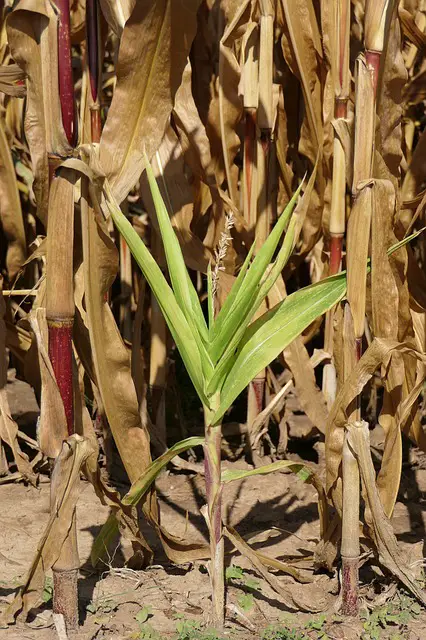When you plant corn for the first time, one of the most crucial elements you must get right is the amount of water so it can develop healthy and tasty. Drought causes corn to turn a yellowish-gray color and slow down the process of growth. Depending on the level of drought, corn can either have smaller kernels or die off.
Corn needs an average of 1 inch (25 mm) of water per week. A 10 x 10 foot (3 x 3 m) ground needs approximately 60 gallons (225 liters) of water per week, which is the result of approximately 5 minutes of watering from a garden hose. Soil organic matter can aid soils in moisture retention, but this would only take effect after several seasons of growth.
| Plantation size | Water needed | Minutes of watering from a garden hose |
| 10 x 10 ft (3 x 3 m) | 60 gallons (225 l) | 6 |
| 30 x 10 ft (9 x 3 m) | 180 gallons (675 l) | 18 |
| 50 x 20 ft (15 x 6 m) | 600 gallons (2250 l) | 60 |
| 50 x 50 ft (15 x 15 m) | 1500 gallons (5625 l) | 150 |
Irrigation is a very effective way of mitigating drought, but it will be practical in places with sufficient sources of water for irrigation. Knowing how corn uses water throughout the season will help you take irrigation applications more seriously. Other factors that affect corns negatively are poor soil quality, planting of seeds too early, and too much nitrogen.
Planting corn so it can thrive
If it’s your first-time planting corn, here are some essential tips to consider before starting;
Learn how to raise your own quail and have an unlimited supply of eggs and meat.
- Understand Your Soil
The type of soil you want to use matters a lot, as well as the slope and drainage of the land. Flat areas with potholes that can create a pond when there’s heavy rainfall will be bad for corn production.
The best soil to use when planting corn is the well-drained field with a slope of 5%. This is not always practical, so don’t worry if you can’t plant on a slope. Just make sure that there are no dips where water ends up being in a pond.
- What To Plant
There are different varieties of corn available, and if you want to plant early, then go for a fully mature seedling as this will be quite suitable. But if you want to plant in the late season, then an early mature speeding will be the most suitable choice.

- Row Spacing
It is advisable to plant lighter if you live in a dry area to reduce competition for available water, and in a wetter area you can bump up the percentage.
- When To Plant
The best time to plant is when the soil temperature is at least 50F and between a 5 -14 day warming tendency ahead. The moisture of the field needs to be sufficient to aid seed germination.
- Field Assessment
Once you have planted successfully, constantly monitor the corns that are emerging and also number the population of the plant. Understanding these things will help you manage future problems and make adjustments when there is a need to.
How to Plant Corn for Beginners
-To increase the rate of germination, wet the seeds and wrap them in a wet paper towel. Keep in a plastic bag for a day.
-Plant the seeds about 1 to 2 inches deep and the soil, spacing them 4 to 6 inches apart and in rows of 30 to 36 inches apart.
-You can select the fertilizer at planting time. A 10-10-10 fertilizer will help the corn grow fast, as long as the soil is suitable.
-Water very well at the early stages of planting
How Much Water Do You Need To Grow Your Corn?
To get a high yield of corn, you need to water it more during the early stage of growth. This stage is also known as the most sensitive to water stress. Lack of water can yield a very low yield and low production of corn. Corn needs a weekly supply of 1 inch of water, especially when the stalks have begun to tassel.
Water stress in the pollination period will lead to ears having missing kernels. If you only have a few plants, you can do it manually, but if you have a larger area to cover, you may want to use a drip irrigation kit. It is very cheap and once you have it installed, it ensures that all of your corn plants get the same amount of water (you can find one here on Amazon).
Corn needs about 1” of water every week for proper growth. Corn prefers to be soaked rather than sparsely sprinkled, that is why they thrive in 1” of rainfall from a storm than a week of sparse rainfall. Therefore, when watering your corn, you should try to imitate stormy weather and give your corn all it needs for the week at a time.
It isn’t necessary to water your corn several times a day or even every day. It’s better for it to be properly soaked once a week as it allows the water to get down to the roots.
Daily watering for a short period will only seep into the few inches of the soil, and may not even get to the roots before evaporation takes place. Also, if you deeply water your corn daily, it’ll make your corn over-watered which is also harmful to it.
The best time to water corn is in the morning, before the sun peaks and the heat begins the evaporation process of the soil, thereby depriving your plants of feeding on the water. By watering your corn early in the morning which is the cooler time of the day, this way water can reach the root effectively.
How Do I Know If My Corn Needs More Water?
If your corn lacks the right amount of water, it’ll become weakened and susceptible to various diseases. It’ll also be prone to insect damage.
If you notice the browning and drying of leaves, this shows water deprivation. This may be due to evaporation do water before it even gets to the roots. An efficient way to fight this is by adding 3-4 inches of mulch into your corn patch. This will greatly aid water retention.
Also, the corn plant has a defense mechanism that rolls its leaves up to reduce the amount of sunlight being used. During hot seasons, corn may roll up even if there is water available. But a very sure sign of under-watered corn is when the leaves are still rolled up, from early morning to pre-dawn hours.

This is a natural symptom of severe stress and will lessen the potential yield of the crop. Also, sandy parts of the field and packed areas can be checked for leaf rolling, to serve as a warning of the moisture level of the other parts of the field.
Without irrigating your corn, yields will be limited and poor. Corn can only survive between 4 weeks and 66 days without irrigation. After this, the size will reduce and corn will eventually wilt off.
How Do I Know If I Over-Watered My Corn?
When you notice the yellowing, wilting, and, falling off of your corn, these are the signs of overwatering. If you notice any of these, decrease the amount of water and watch out for signs of progress. Just like under-watering of plants is bad, overwatering plants is equally bad. Overwatered corn will wilt and eventually die off.
Consider the rainfall and subtract all recent rainfall from your personal watering schedule, to avoid overwatering. If you already got more than an inch of rain, then you don’t need to water the corn again.
How To Best Prepare the Soil To Retain Sufficient But Not Too Much Water?
The best way to prepare the soil for water retention is to increase rooting depth. The main restriction to rooting depth is the acidic subsoils.
The application of lime to 8-12 inches of soil depth, can increase the soil profile drastically and also increase its rooting depth.
Soil retention levels can also increase by adding organic matter like manure or compost and even using mulch.
Adding chemicals will only replenish a few nutrients and won’t strengthen the soil as it ought to.
Most Drought-resistant Corn Varieties
Some of the most drought-resistant corn varieties are Anasazi Sweet, Daymon Morgan’s Kentucky, Butcher, Hopi Blue Flour, Silver Queen Hybrid Sweet, and Tennessee Red Cob.
These types need less amount of water to grow, they are advantageous to semi-arid parts of the world, places where the failure of crops can be terrible to the population.
These types of corn are known to have a crassulacean acid metabolism, which helps them withstand low levels of water.
Harvesting of Corn
Corn is ripe for harvest 3 weeks after the tassel grows at the top of the plant. It is ripe when there’s a milky white juice coming from the kernels, and the silk from the ears is dark brown.
The kernels will look chewy and pasty at this point. The best time to pluck corn is early in the morning or in the cool evening. When harvesting the ears, you should hold the stalk below the ear and twist it towards the ground to break it off. You can either cook it or store it in a refrigerator till you need to use it.
Happy harvesting!
